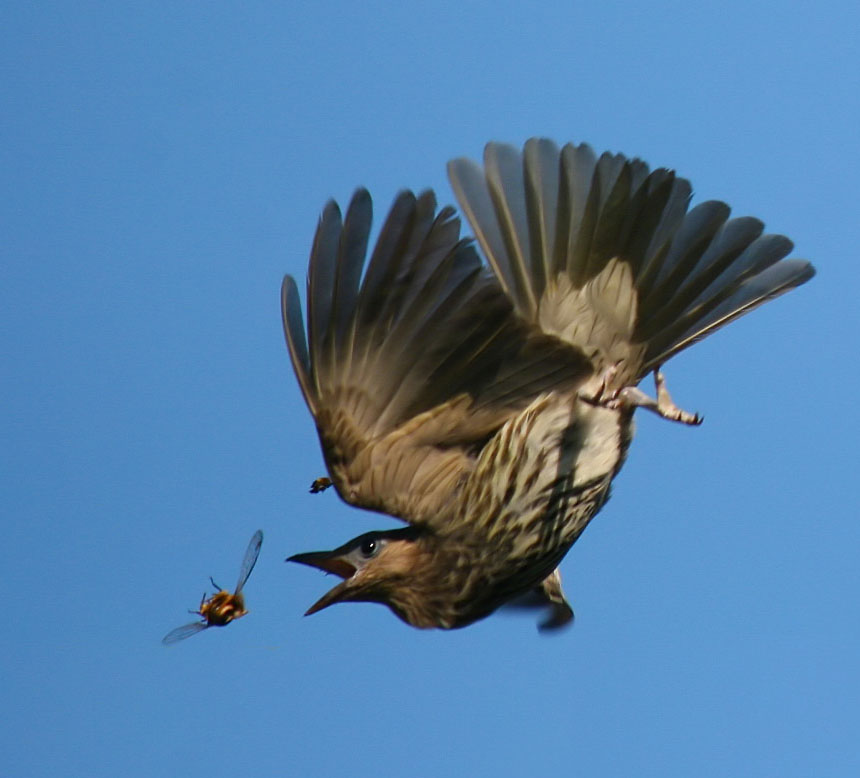Throwing and Catching
I remember once watching a wildlife documentary which had some amazing footage of a raptor catching a small bird mid air. I can't remember the name of the program now, and I've completely failed to find a reusable picture online - it must be quite a rare thing to capture on film. (The picture above shows a bird catching an insect, which is less impressive but illustrates the same thing.)
I was impressed at how the bird of prey changed from a diving posture to one in which its wings were spread and its claws were forward, at exactly the right time. There were no landmarks of any kind and it was impossible for the hunter to know
If the size of the prey is $h$, the distance to the prey is $r(t)$, and the angle subtended by the prey at the eye of the hunter is $\theta(t)$, then to a reasonable approximation
$$
r \theta = h
$$
Differentiating gives
$$
\dot{r}\theta + r\dot{\theta} = 0
$$
We've got rid of the unknown $h$ - the size of the prey - which has disappeared under differentiation. This still leaves $r$, but since $\dot{r}/r = -\frac{1}{T}$ where $T$ is time to impact, we can get rid of the final unknown by dividing by $r$:
$$
-\frac{\theta}{T} + \dot{\theta} = 0
$$
Rearranging gives
$$
T = \frac{\theta}{\dot{\theta}}
$$
So the time until impact is just the time it would take for $\theta$ to double, were it to continue growing at its current rate. But $\theta$ is just proportional to the size of the image on the bird of prey's retina, i.e. it is something the bird of prey can determine, without knowing how big its prey is, or how it or its prey are moving.
This tells us how birds of prey are able to do what they do. But it also tells us that you can't trick a pilot into crashing by building a runway 10 times wider than normal, or a driver by building massive traffic lights! And drawing a tunnel on the side of a mountain won't work, unless the coyote you are trying to escape is not paying attention.
I was impressed at how the bird of prey changed from a diving posture to one in which its wings were spread and its claws were forward, at exactly the right time. There were no landmarks of any kind and it was impossible for the hunter to know
- how fast it was moving
- how fast its prey was moving
- how large its prey was
If the size of the prey is $h$, the distance to the prey is $r(t)$, and the angle subtended by the prey at the eye of the hunter is $\theta(t)$, then to a reasonable approximation
$$
r \theta = h
$$
Differentiating gives
$$
\dot{r}\theta + r\dot{\theta} = 0
$$
We've got rid of the unknown $h$ - the size of the prey - which has disappeared under differentiation. This still leaves $r$, but since $\dot{r}/r = -\frac{1}{T}$ where $T$ is time to impact, we can get rid of the final unknown by dividing by $r$:
$$
-\frac{\theta}{T} + \dot{\theta} = 0
$$
Rearranging gives
$$
T = \frac{\theta}{\dot{\theta}}
$$
So the time until impact is just the time it would take for $\theta$ to double, were it to continue growing at its current rate. But $\theta$ is just proportional to the size of the image on the bird of prey's retina, i.e. it is something the bird of prey can determine, without knowing how big its prey is, or how it or its prey are moving.
This tells us how birds of prey are able to do what they do. But it also tells us that you can't trick a pilot into crashing by building a runway 10 times wider than normal, or a driver by building massive traffic lights! And drawing a tunnel on the side of a mountain won't work, unless the coyote you are trying to escape is not paying attention.




Comments
Post a Comment